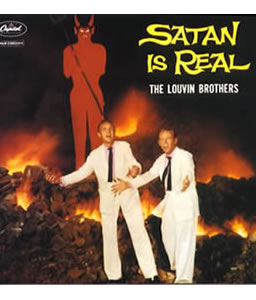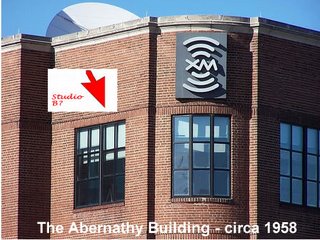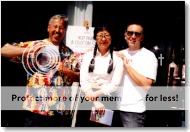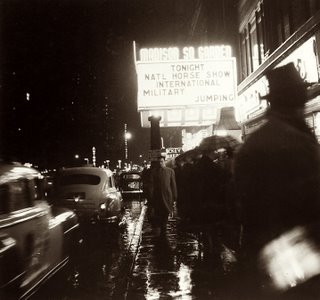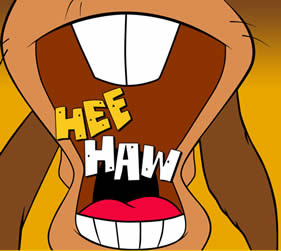Episode 11 - All Mobbed Up
Subscribe to Dreamtime
[Intro]
["A word from our sponsor," from the Cars episode of "Theme Time"]
[Frank - Ol' MacDonald goes to Pete Epsteen's Pontiac]
Why do you think? Three little letters. M.O.B.
Most of the references on the Web claim that Sinatra did the gig for Sam Giancana, boss of bosses in Chicago from the late `50s to the mid-60s, a friend - if friend is the right word - of Sinatra's since 1958, and the person who Sinatra acted as the front for in his buy into a piece of the action of the Cal/Neva Casino in Lake Tahoe.
However, it's more likely that the favor was asked by one of the Fischetti brothers, Rocco, Charlie, and Joe. Charlie Fischetti was the Mob's political fixer in Chicago, and a friend of Sinatra's since the early `40s. Sinatra, nice guy that he was, used to go along with Charlie when he visited his mother in Brooklyn. Charlie died in 1951, but Sinatra and Joe Fischetti were also close friends. He took a trip to Cuba with the brothers in 1946, the so-called "Havana Summit" held by Lucky Luciano, a trip that would haunt Sinatra for the rest of his career.
But Frank still did a lot of favors for the Fischetti brothers. He once rode along on a plane ride from Palm Springs to Vegas so the Fischettis could impress a star struck automobile tycoon from Detroit who they were romancing for an agency franchise. In fact, Sinatra helped the Fischettis set up a string of auto dealerships - including Pete Epsteen Pontiac - by lending his name to the enterprise and doing commercials free of charge, at least from a cash aspect. Sinatra reportedly received at least two Thunderbirds that became the property of Sinatra Enterprises.
Interestingly, Lee Iacocca notes in his autobiography that Sinatra offered to do commercials for the failing Chrysler for the nominal fee of a buck… plus stock options. Frank had apparently learned that some things were better than money, and should have made a bundle from those options, according to Iacocca.
In any case, a helpful guy to his friends, Sinatra was. And hey, your other friends should help out your friends too, right? So Sinatra wasn't the only crooner to warble for Ol' Pete. He called in the Rat Pack.
[Sammy segment]
When the Chairman called for a favor, Sammy was always there, recording not one, not two, but three separate commercials for Pete Epsteen Pontiac.
Like his explanation for freebie gigs at the Villa Venice Supper Club - which indeed were done as favors for Sam Giancana, Sammy probably would have responded if asked, "I have to say it's for my man Francis." And if pressed might have answered, "Baby, let me say this. I got one eye, and that one eye sees a lot of things that my brain tells me I shouldn't talk about. Because my brain says that, if I do, my one eye might not be seeing anything after a while."
[Dino segment]
Like Sammy, Dino probably did the shtick as a favor for Frank without a second thought. Unlike Sammy, Martin probably gave less than a flying chiavare about whether the boys were involved. While Martin knew mobsters - as Jerry Lewis says in his memoir about Dean, "Dean and Me," it was impossible to work the nightclub circuit from the `40s to the `60s without becoming involved with the mob - he mostly ignored them, and in turn they mostly left him alone.
Unlike Frank, who had this thing about impressing mobsters and liked hanging with them, and unlike Sammy, who was a black guy in a white guy's world and trying to keep his other eye, Dino was known as an "okay guy" who the arm wasn't to be put on… at least not much.
So, Pete Epsteen. What do we know about him? The Sacramento Bee newspaper once published a story entitled, "Palm Springs - Where Stars, Pols - and Mobsters - Live in Style." Although not mentioned in the article, Pete Epsteen was referred to in a photo caption as "an automobile dealer financed by the Mafia."
Represented by Sinatra's attorney, Mickey Rudin, Epsteen filed a $6 million libel suit against the newspaper. He denied any affiliation with the Mafia and demanded a retraction. The Sacramento Bee published a story reporting Epsteen's denial but did not retract the charge.
Lawyers representing the newspaper hired a former FBI agent to investigate. He later told Kitty Kelly, author of "His Way," "I flew to Chicago and met with a lower-level Mob boss and told him we were going to subpoena all the top Chicago Mafia chieftains as hostile witnesses to prove their connections with Epsteen. He told me he'd pass the word up and a few weeks later Epsteen dropped his lawsuit."
According to a Google Search, Epsteen divorced his wife in the `70s, moved to California, and opened a Honda dealership. In 1995 he was prosecuted for his role in a kickback scheme in which dealers in 30 states gave executives of American Honda up to $15 million in cash and gifts in exchange for hot-selling cars and franchises. He was also convicted of perjury in the case, fined $200,000, and sentenced to six months in prison. He died in 1997, in Palm Springs, California.
They're all gone. Giancana. The Fischettis. Sammy took his bows in 1990. Dino would follow in 1995. And Sinatra walked off stage in 1998.
All that's left is the music… and the stories.
This has been Fred Bals with the Dreamtime podcast - occasional commentary on Bob Dylan's Theme Time Radio Hour weekly show. Dreamtime is not associated with XM Radio or Bob Dylan, and takes the Fifth about any association with known gangsters.
We'll be on vacation for a few weeks, so until next month, sweet dreams.
["Birth of the Blues" segment, Frank, Dean, and Sammy]
Sources: His Way: An Unauthorized Biography Of Frank Sinatra by Kitty Kelley; New York Times article, September 9, 1995 - "Two Sentenced in Honda Case"; Appeal from the
Circuit Court of Cook County IN RE THE MARRIAGE OF: MARILYN D. EPSTEEN, Plaintiff,and MARY B. EPSTEEN, as Executrix of the Estate of PETER EPSTEEN, Defendant. Searches on variations of "Peter" and "Pete Epsteen."
There are various articles/accounts of Sinatra's involvement with the Fischettis and other mob figures, most notably Sam Giancana, available on the Web. My primary sources were CrimeLibrary.com and AmericanMafia.com. Shirley Maclaine's remembrance of an encounter with Sam Giancana while in her role as Rat Pack mascot was also instructive.
The "Theme Time" research team appear to have used the same source as I did for Sinatra's Pete Epsteen Pontiac commercial. I sampled it from a widely-circulated bootleg, "Dean Martin at the Sands," which is regularly available on eBay. The Martin and Davis commercials I use were also taken from the same CD, which includes as "bonus tracks" those commercials, as well as Davis also doing Pete Epsteen commercials using "Come Fly with Me," and "Rubber Tree Plant" (aka "High Hopes") as the music.
The closing music was taken from another Rat Pack bootleg, "Live at Villa Venice - 1962," a two-CD set of the Rat Pack in all their political incorrectness doing two free shows for Sam Giancana's night club; one story has it as payback for Giancana delivering West Virginia to JFK in the presidential primaries.
It's a tangled web.



